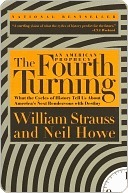More on this book
Community
Kindle Notes & Highlights
Read between
August 13 - December 8, 2018
millions of self-actualized persons don't add up to an actualized society.
the man of a traditional culture sees himself as real only to the extent that he ceases to be himself (for a modern observer) and is satisfied with imitating and repeating gestures of another.”
opportunity to remake man and therein put an end to history.
Thus arose the dogma of American exceptionalism, the belief that this nation and its people had somehow broken loose from any risk of cyclical regress.
A linear society defines explicit moral goals (justice, equality) or material goals (comfort, abundance) and then sets out deliberately to attain them.
without some notion of historical recurrence, no one can meaningfully discuss the past at all.
natural capacity to achieve homeostasis by continual minor readjustment.
history as riding on such serendipities as a slim electoral margin, a barely won battle, an improbable invention, or an
assassin's fateful marksmanship.
undergo a wrenching upheaval before they can fundamentally improve. That instinct is correct.
siecle-lzngth
gradual decay of the “living memory of a previous war.”
Toynbee believed that “human control… can diminish the discord and increase the harmony in human life.”
four-part war cycle, which alternates between bipolar eras of war and multipolar eras of “power vacuum.”
a cycle-ending war is one with decisive social and political consequences. It must end an era.
European balance of power has shifted profoundly once a century.
the Toynbean cycle as a consequence of capitalist development.
“Over a period of time (roughly 100 years) a world power emerges from a global war only to experience a gradual decay in its position of preponderance,”
“Global order decays at a parallel rate until a new global war occurs and facilitates the emergence of
a new world ...
This highlight has been truncated due to consecutive passage length restrictions.
In the first world power phase, both the (social) demand for order and the (political) supply of order is high. In the delegitimizing phase, the demand for order declines. In the deconcentration phase, the supply of order declines. The cycle culminates when the demand for order rises, leading to an order-producing era of global war.
universal perception that an old global structure
of politics has perished and a new one is born.
purifying and transmuting fire that ends one circle and starts the next.
periodic total wars that Marx called “express trains of history.”
“a sudden acceleration of the historical process in a terrifying manner,” sufficient to “release economic, social, and moral forces of unforeseen power and dimensions, which often make return to the status quo impossible.”
“internal renovation” and “revitalization of the system's normative foundations.”
a “deliberate, organized, conscious effort by members of a society to construct a more satisfying culture.”
a transformed understanding of “nature, society, culture, personality, and body image.”
all of today's established religions are the ossified remains of the “prophetic and ecstatic visions” of past movements.
The dry phrase revitalization movement is dropped in favor of a gnostic image long popular among Westerners—the image of an awakening of the spirit, or simply Awakening:
loaded with passionate attacks against the morality of cultural and religious norms that felt old at the time. All were spearheaded by young people.
the anxiety born of growing insecurity triggers an outburst of strife that reestablishes order.
Where the cyclical spring brings consensus, order, and stability, the autumn brings argument, fragmentation, and uncertainty.
When the newcomers first met the natives, what they chose to see were golden-age “Indians” or infernal devils—static images of the end of history.
What these migrants did not seek—indeed, what they were fleeing—was a pagan resignation to the seasonality of nature.
became the wonder of the free world—and the envy of its new Soviet rival.
The Great Awakening (1727-1746; climax, 1741)
The Transcendental Awakening (1822-1844; climax, 1831)
Entering the Awakening, America's global reputation was a nation whose institutions could build anything but whose culture could imagine nothing; it emerged with that reputation reversed.
Paradoxically, modern history does not beat to a rhythm invented by great nations, with all their vast economies, armies, and institutions—but to a natural rhythm, the rhythm of life itself,
Across all cultures and epochs, all classes and races, the experience of aging is a universal denominator of the human condition.
in modern times, boosters of progress have been reluctant to acknowledge a rhythmic force that would undermine their agenda.
While modernity is about rational progress toward the future, generations stand as reminders of how much people remain tied to the subconscious vestiges of their past.
modern elites simply seal off the historical importance of generations with a high wall of skepticism.
No one formally defined it that way; people just knew.
any generation includes what he called “directive,” “directed,” and “suppressed” members. The directive members set the overall tone; the directed follow cues (and thereby legitimize the tone); and the suppressed either withdraw from that tone or, more rarely, battle against it.
The Silent see their work as smoothing out the harsh edges of life—a
Roughly once every twenty years, America discovers a new generation—a happenstance triggered by some striking event in which young people appear to behave in ways manifestly different than the youth who came just before.


